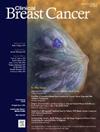具有不同 HER2 荧光原位杂交模式的乳腺癌中 HER2 蛋白的临床病理特征和数字成像分析
IF 2.9
3区 医学
Q2 ONCOLOGY
引用次数: 0
摘要
背景:HER2靶向疗法大大改善了HER2阳性乳腺癌(BC)患者的预后,HER2阳性乳腺癌患者占所有BC病例的15%至20%。HER2状态通过免疫组化(IHC)和/或原位杂交(ISH)进行评估,将乳腺癌分为五组(G1-G5):在对2702例原发性BC(包括12.7%的G1、0.2%的G2、2.8%的G3、8.5%的G4和75.9%的G5)进行的研究中,我们对每个ISH组的临床病理特征和HER2蛋白表达进行了数字化分析:值得注意的是,与其他组别相比,G5 病例的小叶癌比例更高(13.9%)。G3病例中3级肿瘤的比例最高(56.9%),而G5病例中3级肿瘤的比例最低(21.4%)。此外,G5 病例的雌激素受体(ER)阳性率最高(84.6%),而 G1-HC(高拷贝数)病例的雌激素受体阳性率最低(70.4%)。大多数 G1-HC 病例的 HER2 IHC 为 3+(76.1%),而大多数 G5 病例的 IHC 为 0/1+(75.7%)。IHC 2+ 在 G1-LC(低拷贝数)和 G3 病例中最为常见(分别为 83.8% 和 90.7%),G4 病例主要是 IHC 2+ (56.3%)和 IHC 1+ (30.1%)。有12例(0.4%)患者的HER2 IHC和ISH结果不一致,包括7例G1-HC(2.3%)、4例G1-LC(10.8%)和1例G5(0.1%)。对除G5以外所有组别的HER2 IHC水平进行数字量化后发现,G1-HC肿瘤的HER2蛋白表达量最高,其次是G3,G4最低:这些发现为不同 HER2 ISH 组的临床病理特征和未来管理提供了有价值的见解。本文章由计算机程序翻译,如有差异,请以英文原文为准。
Clinicopathologic Features and Digital Imaging Analysis of HER2 Protein in Breast Carcinomas With Different HER2 Fluorescence in Situ Hybridization Patterns
Background
HER2-targeted therapies have significantly improved outcomes for patients with HER2-positive breast cancer (BC), which represents 15% to 20% of all BC cases. HER2 status is assessed via immunohistochemistry (IHC) and/or in situ hybridization (ISH), dividing BCs into five groups (G1-G5).
Patients and methods
In a study of 2,702 primary BC cases, comprising 12.7% G1, 0.2% G2, 2.8% G3, 8.5% G4, and 75.9% G5, we analyzed clinicopathologic features and HER2 protein expression digitally for each ISH group.
Results
Notably, G5 cases had a higher proportion of lobular carcinoma (13.9%) compared to other groups. G3 cases showed the highest percentage of grade 3 tumors (56.9%), while G5 cases had the lowest (21.4%). Additionally, G5 cases had the highest rate of estrogen receptor (ER) positivity (84.6%), while G1-HC (high copy number) cases had the lowest (70.4%). Most G1-HC cases were HER2 IHC 3+ (76.1%), while most G5 cases were IHC 0/1+ (75.7%). IHC 2+ was most common in G1-LC (low copy number) and G3 cases (83.8% and 90.7%, respectively), with G4 cases predominantly IHC 2+ (56.3%) and IHC 1+ (30.1%). Discordant HER2 IHC and ISH results were observed in 12 cases (0.4%), including 7 G1-HC (2.3%), 4 G1-LC (10.8%), and 1 G5 case (0.1%). Digital quantification of HER2 IHC levels in all groups except G5 revealed that G1-HC tumors had the highest HER2 protein expression, followed by G3, with G4 showing the lowest.
Conclusion
These findings offer valuable insights into the clinicopathologic characteristics and future management for different HER2 ISH groups.
求助全文
通过发布文献求助,成功后即可免费获取论文全文。
去求助
来源期刊

Clinical breast cancer
医学-肿瘤学
CiteScore
5.40
自引率
3.20%
发文量
174
审稿时长
48 days
期刊介绍:
Clinical Breast Cancer is a peer-reviewed bimonthly journal that publishes original articles describing various aspects of clinical and translational research of breast cancer. Clinical Breast Cancer is devoted to articles on detection, diagnosis, prevention, and treatment of breast cancer. The main emphasis is on recent scientific developments in all areas related to breast cancer. Specific areas of interest include clinical research reports from various therapeutic modalities, cancer genetics, drug sensitivity and resistance, novel imaging, tumor genomics, biomarkers, and chemoprevention strategies.
 求助内容:
求助内容: 应助结果提醒方式:
应助结果提醒方式:


